Writing is another creative outlet I enjoy.
In this creative writing sample, I critique the art of Ralph Steadman on Flying Dog's Raging Bitch IPA label. [Originally written in 2014, edited in 2017]
Advertising and design are everywhere around us, influencing us, consciously and subconsciously, to think and feel a certain way. At any given moment, companies are buying and vying for our attention using such design devices as ads, product labels, and branding. To succeed, the product must first catch the consumer’s attention and second, must be memorable, recognizable, and consistent. Flying Dog Brewery is a company that has successfully co-branded their product with British artist, Ralph Steadman’s designs to produce a highly recognizable and memorable product that says “Flying Dog” without even having to say it.
In the 1990’s, FDB founder, George Stranahan, became friends with Hunter S. Thompson and Ralph Steadman and for anyone who has ever seen Fear and Loathing in Las Vegas, the appeal of Mr. Thompson is apparent. In an attempt to target consumers who identify with or desire to identify with the counterculture and alternative lifestyles associated with Mr. Thompson, documented by the Gonzo style of journalism and art, Stranahan, Thompson, and Steadman collaborated to form their current branding scheme; provocative names, Steadman art, and good beer. One of Flying Dog’s most famous beers is their Raging Bitch IPA.
In this work, Steadman has illustrated a female dog (presumably in heat) with swollen teats and genitalia, bared teeth, red claws, and lipstick. The creature is standing on what seems to be fleshy rolls with a pair of breasts. She is growling fiercely at the viewer. The dog’s tail fantastically becomes an abstract anatomical representation of parts of the ear. The background is abstract as well, with splatters of watercolor, as not to detract from the subject. Steadman’s style is rough, sketchy, and riddled with inkblots, all intentional and all contributing to an overall grungy and chaotic feel. The type Steadman has created is messy, imperfect, and obviously hand-drawn using red ink reminiscent of menstrual blood. The shades of red and other warm tones in the art reinforce the implied sense of “rage” (hello, ever heard the expression “seeing red”). The “wildness” of the art parallels the description of the beer, which compares the flavor to “a wild animal locked up” and “nectar imprisoned in a bottle”. The label encourages drinkers to enjoy the beverage “unleashed, untamed, unbridled – and in-heat”, as the dog on the front appears to be, perhaps suggesting that by drinking Raging Bitch, you will release that wild part of yourself that is “pure GONZO”[i].
As an artist, Steadman is reluctant to use purely vertical, horizontal, or any straight lines in his work. His style is marked by an organic, non-geometric feel (which some may find to be chaotic), that mirrors the unconventional feel of his longtime friend, Hunter S. Thompson’s gonzo style of journalism. In 1970, the term “gonzo journalism” was coined by Boston Globe editor Bill Cardoso in response to one of Thompson’s articles, The Kentucky Derby is Decadent and Depraved. “Cardoso claimed that "gonzo" was South Boston Irish slang describing the last man standing after an all-night drinking marathon”[ii] – how appropriate! Steadman’s subjects are often fantastical or grotesque, alluding to the influence of substance, particularly psychedelics, that influenced Hunter S. Thompson and his work. Steadman’s use of paint drips, quick strokes, and asymmetry create active and visually engaging pieces. “Asymmetry is generally associated with fewer rules and limits, and more expressive possibilities”[iii]. By this definition, one could call Thompson’s style of journalism asymmetrical as well as Flying Dog’s style of beer crafting. In a world of rules and structure, this sense of lawlessness is appealing and almost sexy in a feral way.
The imagery and phrasing on the Raging Bitch label is, in Steadman’s own words, “inflammatory”, or “tending to excite anger, disorder, or tumult”[iv]. Art that is controversial or even offensive is often the most effective at being noticed (and being noticed is coincidentally great for branding and advertising). These types of work spark the very debates and publicity intended by the artist. Some say that “all publicity is good publicity” and that holds true when, despite disliking an artist, you still know their name or talk about their work. By using the “B word” and Steadman’s raunchy graphic, Flying Dog is basically saying, “you don’t have to like us, but you’ll know who we are”. This honest approach is likely refreshing to consumers who are tired of feeling tricked by advertising and design. You can tell from a glance that this beer is not for the faint of heart or the easily offended.
As a woman perceiving this image, I am not personally offended by the implied connection between hormones and emotions and here’s why: there is a proven scientific connection between hormones and emotions. Furthermore, all animals experience hormonal fluctuations as a crucial part of their biology, including the males of these species, even human males[v]. Not everybody reacts in the same way to hormonal changes but a stereotype is a stereotype for a reason and there are females who react quite poorly to the changes that occur before and/or during their “time of the month”, also known as PMS. For those who suffer with PMS, this image may very well be offensive! Flying Dog, however, clearly doesn’t give a flying f—.
On that note, let’s discuss the use of profanity. The Michigan Liquor Commission banned the beer and New Hampshire and Texas prohibited its sales and distribution in their states due entirely to the use of profanity. “[Flying Dog’s] Road Dog Porter is banned in Texas because its label has the company’s slogan, which contains a profanity that was part of the original artwork that Steadman submitted to Flying Dog” spokeswoman Erin Biles said[vi]. As for the trouble with Michigan, “the controversy began in September 2009, when we applied for a license to sell Raging Bitch, then our 20th anniversary commemorative beer, in the state of Michigan. The Commission then barred the sale of Raging Bitch, claiming that the beer’s label is ‘detrimental to public health, safety, and welfare’”, said Flying Dog rep[vii]. To say that an image or word could be “detrimental” to “public health [and] safety” seems appalling to me. Jim Caruso, Flying Dog CEO, has said on the matter, “This is about much more than a beer label. It’s about regulators gradually morphing into the thought police. We believe not only in the freedom of speech and artistic expression for both businesses and individuals, but also in the right to choose or reject books, art, literature and artisanal craft beer”[viii]. The company uses Steadman’s art to form an association between its product and these values, which, as numerous lawsuits against the company prove, are not values shared by all Americans.
I, personally, get a kick out of the whole commotion. The solution, to me, is simple: if the design offends you, don’t buy the beer. Furthermore, given that beer sales are 21 and up, I should hope these adult consumers are mature enough to know that while sticks and stones may break our bones, words and drawings can never truly hurt us, especially not in the physically sense as the Michigan Liquor Commission implied. One of the first rules of designing is to “remember that everything you design will be seen by other people and as such, you must “think about the people who will be looking at your design”[ix]. With the target audience already limited to adults, Flying Dog is specifically targeting those who are neither straight-laced nor corporate and is willing to sacrifice the business of those who are in exchange for the loyal patronage of the alternative. Flying Dog is a company that prides themselves on their values and isn’t willing to compromise their design. Their current Twitter bio reads, “Craft beer crusaders and defenders of the First Amendment for over 25 years” – at this point, offending people in the name of Freedom of Speech is kind of their shtick. And I for one, like that.
Cheers, Flying Dog!
[i] Steadman, Ralph, Raging Bitch IPA label
[ii] Thompson, Hunter S. (1997). The Proud Highway: Saga of a Desperate Southern Gentleman. Villard. ISBN 0-679-40695-6
[iii] Dabner, Stewart, and Zempol. Graphic Design School. Fifth ed. Hoboken, New Jersey: John Wiley & Sons, 2014. 38.
[iv] "Inflammatory." Merriam-Webster. Merriam-Webster, n.d. Web. 11 May 2017.
[v] Bartekian, Vatche. “Mood Swings.” AskMen. Web.
[vi] Huntemann, Chris. “Flying Dog’s ‘Raging Bitch’ Beer Label Sparks Suit.” Gazette.net. March 31, 2011. Web.
[vii] “Victory for Raging Bitch, but Our First Amendment Fight with Michigan Rages On – Flying Dog Brewery.” Flying Dog Blogs. Web.
[viii] Milmo, Cahal. “Ralph Steadman and the Beer That Outraged the US.” The Independent. April 2, 2011. Web.
[ix] Dabner, David, Sandra Stewart, and Eric Zempol. Graphic Design School. Fifth ed. Hoboken, New Jersey: John Wiley & Sons, 2014. 24.
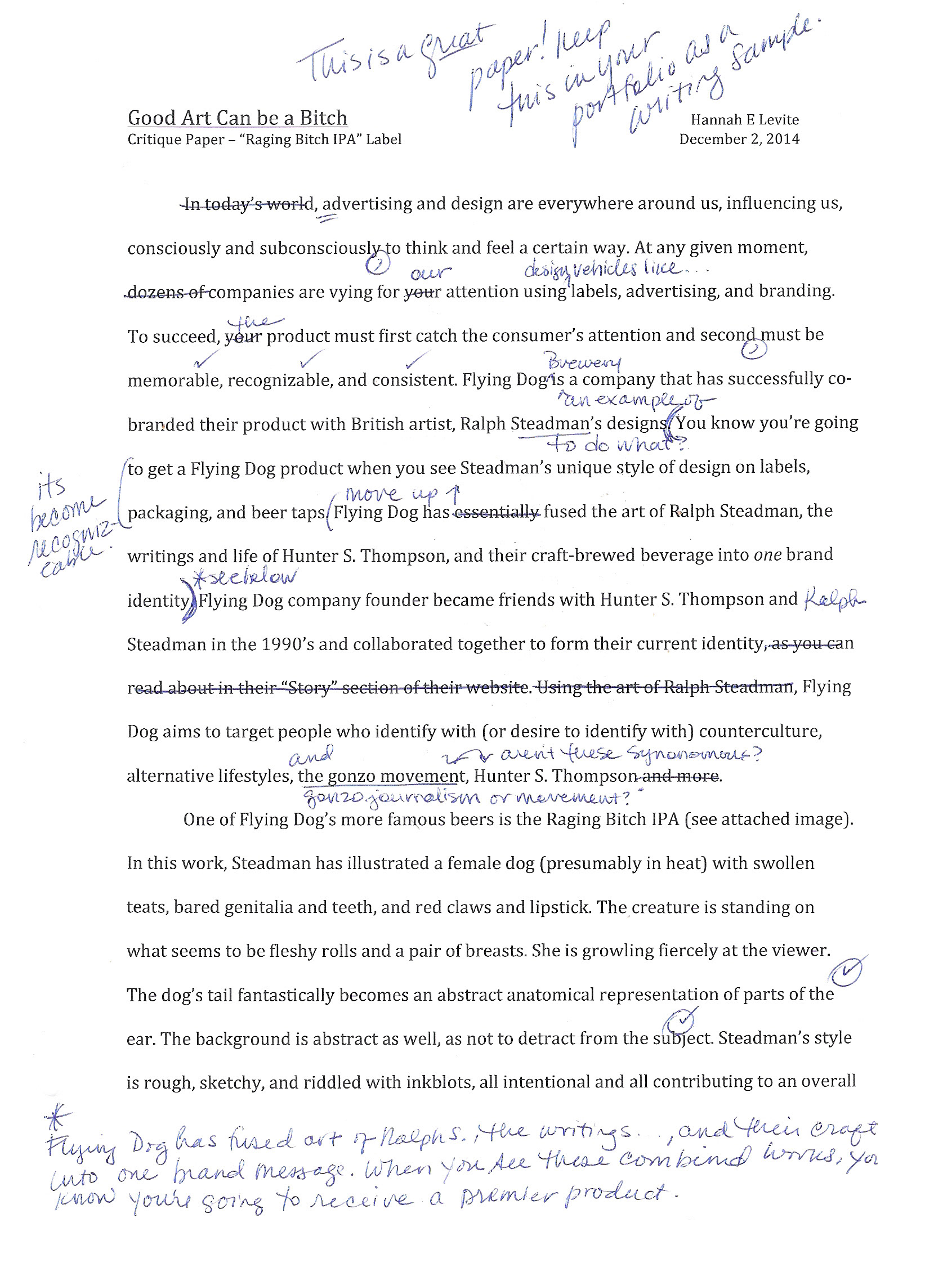
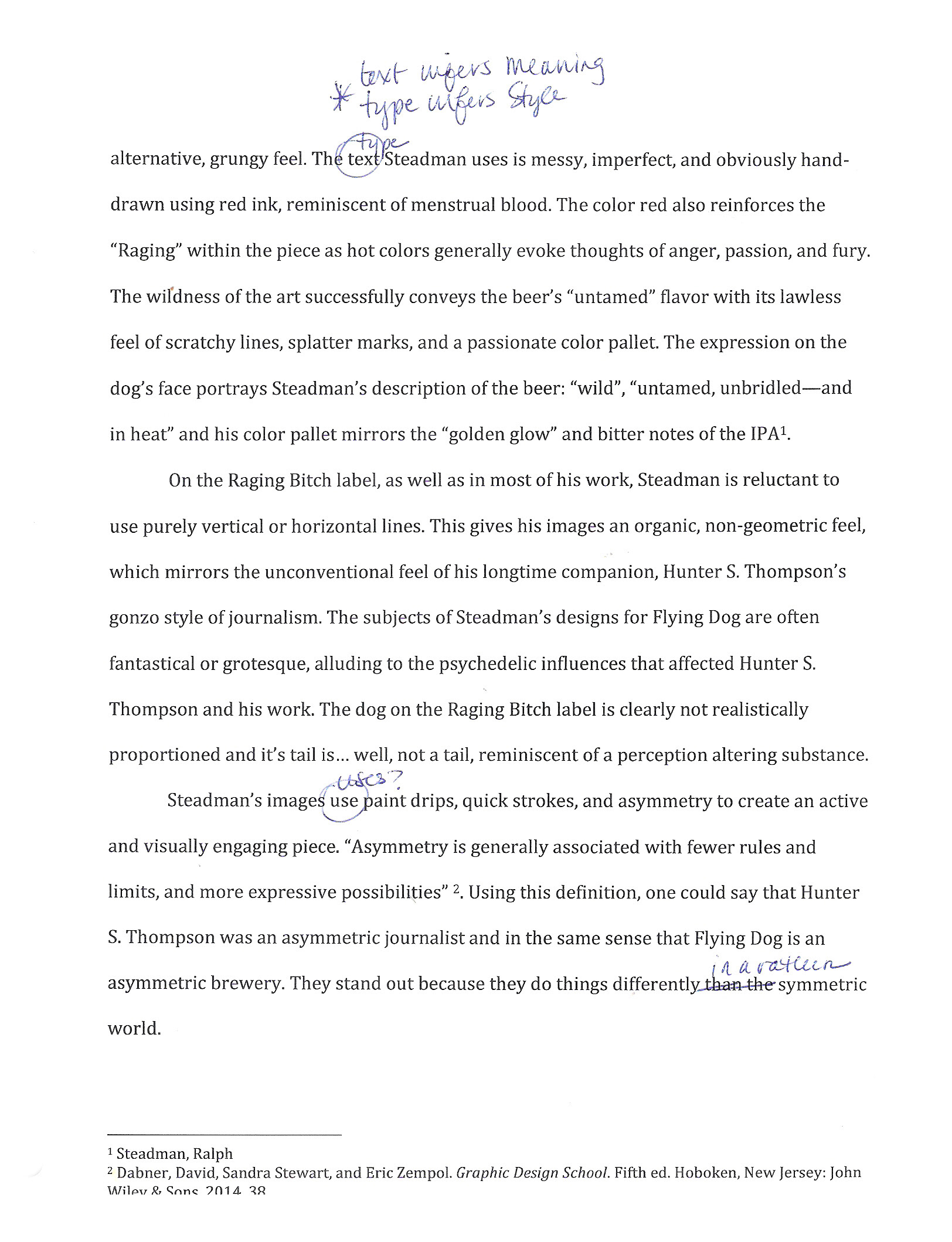
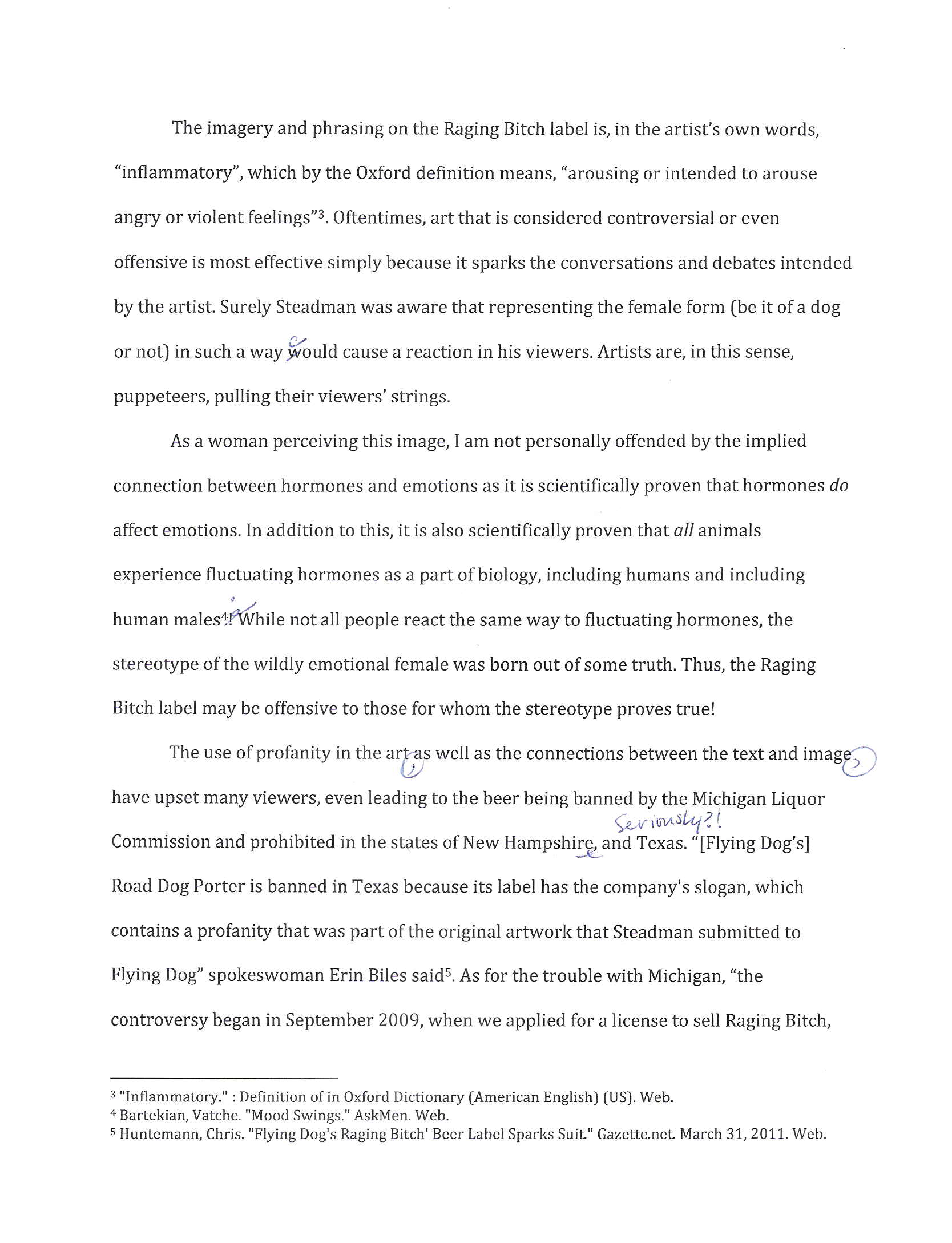
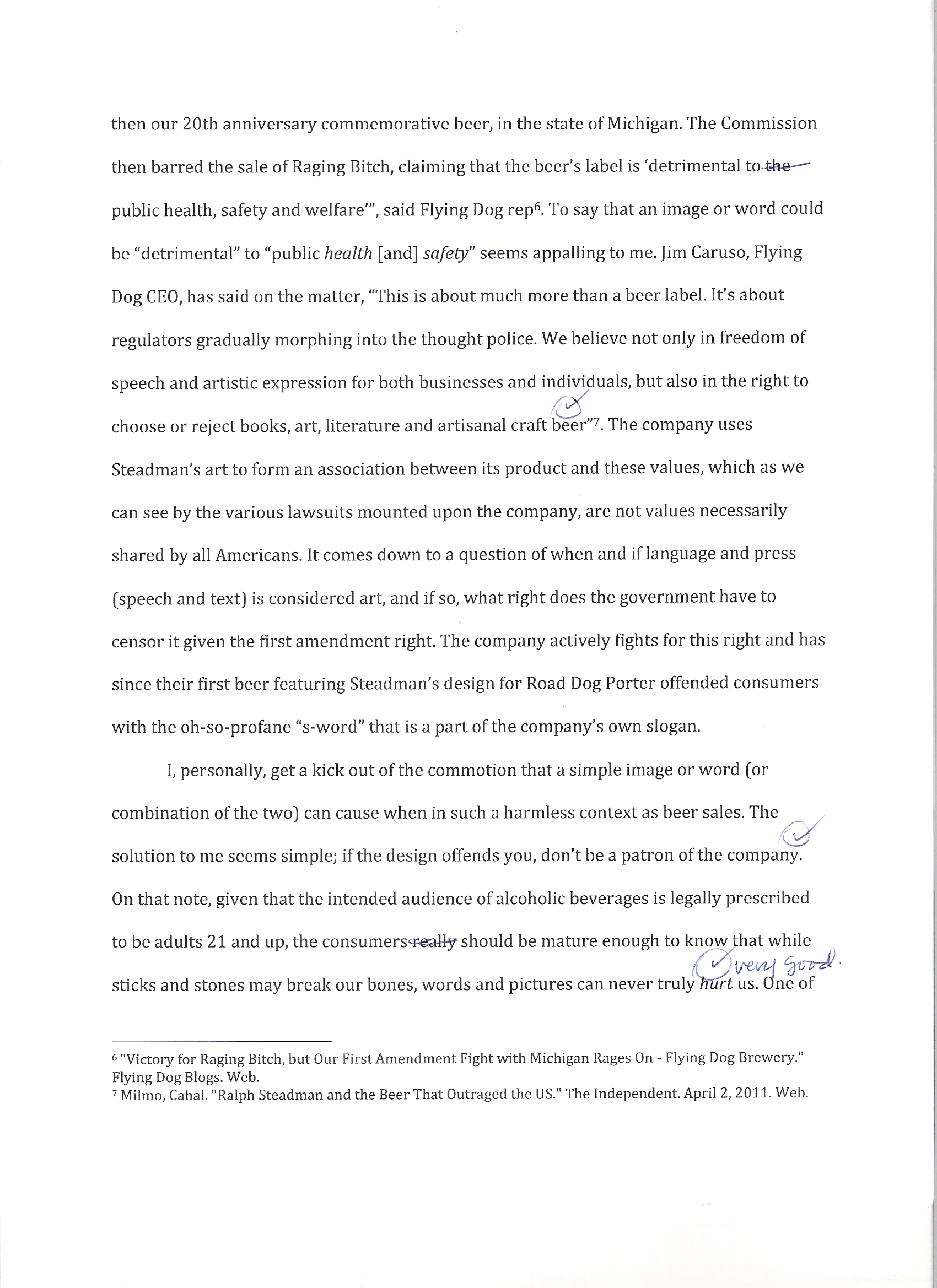
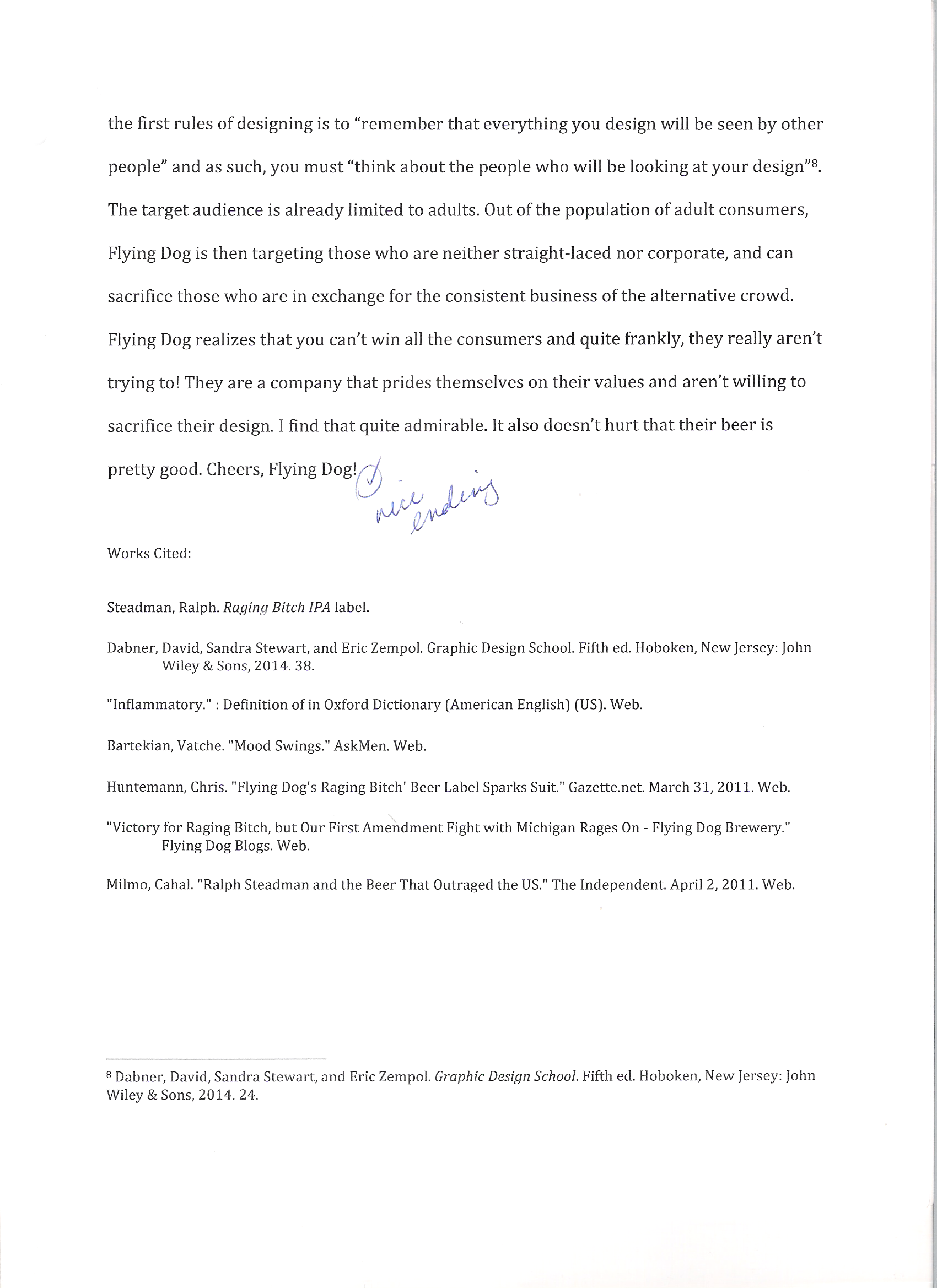
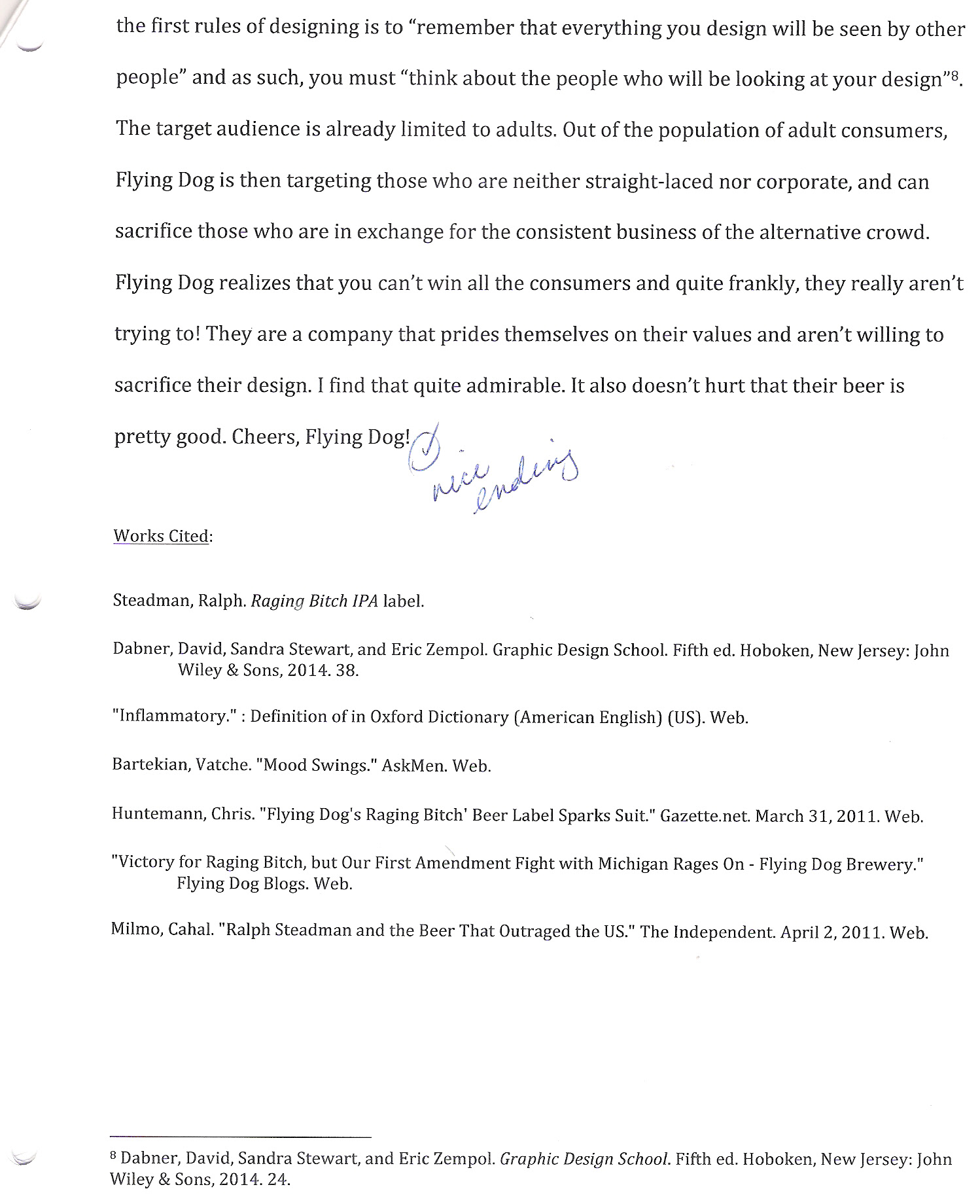
The original essay was an assignment for a college English class, graded by Professor Wakeman-Linn, 2014.